|
Topic
& cover
|
Title
& Review
(Click the book graphic or title for
more
information and for ordering through Amazon.com)
|
|
Building
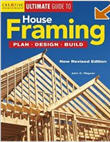
Click
image to order
|
House
Framing
by John D. Wagner
"Probably the best framing guide available for
standard
wood frame construction."
Much information and very clear graphics for the
new
builder. Includes tools, safety equipment, basic engineering concepts,
choosing hardware and all the essential framing techniques. Covers
framing of walls, floors, roofs (gable, hip, shed, gambrel), dormers,
stairs and even a bay window.
If you could only read one book and you wanted to
learn
enough to build a simple house - this is the one to get.
|
|
Building
& Design
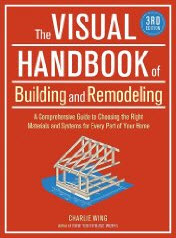
Click
image to order
|
Visual
Handbook of Building and Remodeling
by Charlie Wing
Charlie (Dr. Charles G.) Wing is perhaps the most
creditable house building teacher in the world. Co-founder of the first
owner-builder school (The
Shelter Institute) his writing and teaching make complex
issues understandable and buildable. With crystal-clear illustrations
and explanations,
this thick book (now in the 3rd edition) will become your encyclopedia
of
house building. Covers
all aspects of building including electrical and plumbing,
heating & cooling, insulation, drywall, tile work, trim out,
and
cabinets.
As a physics professor Wing has some great
information on the
building science of how houses work. His old 1976 book (From the Ground
Up) was where I was finally able to understand the basic engineering of
how forces go through a building. Check out your library to find his
earlier books - all of which are great and packed with good
information.
Wing's body of work is the history of the owner-builder movement.
If you can get a second book on home
building
this would be my suggestion. Much more detailed than the great Wagnor
book above, you will continue to go back to this
referrence for years to come.
|
|
Building

Click
image to order
|
Working
Alone : Tips & Techniques for Solo Building
by John Carroll.
A step by step book for solving many of those
tricky
questions most new builders face. The author gives us practical
solutions you won't find in even the best carpentry books. He uses
simple jigs, clamps and brackets to build safely and accurately and
without requiring an extra pair of hands. You continually say "why
didn't I think of that?" Includes procedures for leveling and laying
out foundations, framing steep pitched roofs, building overhangs and
much more. Learn how to use measuring sticks in place of floppy tape
measures, hoist heavy beams overhead all by yourself.... You get the
idea.
Read this book before you finalize your tool
list.
Carroll uses inexpensive tools that he modifies slightly to be much
more valuable to the solo builder or the small building crew.
My third suggestion for a building book. This
isn't the
first book to read, but it's invaluable for the (soon-to-be) wise
owner-builder.
|
|
Design
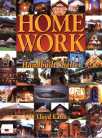
Click
image to order
|
Home
Work - Handbuilt Shelter
by Lloyd Kahn
This book is a sequel to Kahn's 1973 book
"Shelter". A
large oversized book with some 1100 photos and over 300 drawings, it is
difficult to put down. Some of the best photography you will ever see
illustrates shelter from around the world - all built by hand
and generally without outside professional help. This book will give
you a window into vernacular
architecture - not the kind that comes in a box, but the kinds of homes
and buildings people make using materials they find around
them.
The rest of the world knows about this type of
building
and much of it has evolved over hundreds of years or more. There are
modern examples as well... Hippy vans, naked builders, Flying Concrete,
ferrocement houses, natural houses, unnatural houses, earth houses,
boat houses, tree houses, fantasy houses, a greenhouse built out of old
car windshields.
More great houses and buildings than you could
ever
imagine, simply because many of these places are beyond imagination.
This is inspiring me to go finish my secret room so I can show
everybody. Be forewarned, there are things in this book that are
guaranteed to inspire you to do something weird just because they are
so interesting looking.
If you are looking for inspiration and want to
get away
from the cookie cutter look, want something different, or just want to
look at pictures because you can't read, then I highly recommend that
you get this book. You won't be sorry. (Review
by Glenn Kangiser). Order directly from the Shelter
Online Store. Or, from
Amazon.
PS - Kahn's latest book is Builders
of the Pacific Coast. Here is a link to Lloyd Kahn's
Blog.
|
|
Design
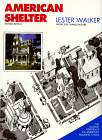
Click
image to order
|
American
Shelter
by Lester Walker
Les Walker is a great teacher. You'll find you're
looking at American history with a fresh viewpoint when you see it
through the evolution of what we've built to live in. Through the use
of simple but very understandable line drawings this book lets you
mentally build and then walk inside most of the
house ideas that have been tried on
this continent. You start with a Native
American wigwam, hogan, or plank house, then move on to the
colonial settlers and see them build their first
houses with pit-sawn timbers and thatched roofs - techniques
they brought with them from the old world.
Later wood frame construction with machine cut
lumber
allowed greater freedom and led to many great period styles
as American wealth increased. The same type of
drawings explain the evolution and construction of later house
building techniques and styles including
sod, strawbale, mobile homes, modular homes, domes, yurts and
houseboats.
|
|
Land
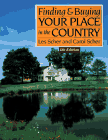
Click
image to order
|
Finding
and Buying your Place in the Country
by Les and Carol Scher
This book was initially self-published in 1974 by
a
real estate lawyer who moved to northern California to build a
homestead. The book was about what he was learning from his
own experience and those of his neighbors. My first edition copy shows
a picture of a skinny, hippy-looking fellow and his flower-child
girlfriend. The latest (4th edition) shows a picture of a somewhat
paunchy lawyer with a matronly wife and their two teenage daughters.
Everyone's still smiling and they're still on the homestead.
Scher has continued to learn (now mostly from
readers
who write in with their stories) and continually update his book. This
book will be invaluable in researching and purchasing property in your
chosen locale. Like any good lawyer, Scher helps you review the
pitfalls and potential problems of land purchase. This is a good
resource for working with agents and owners, and a real book about real
experience. If you will be buying property, let this be your first
investment in the process.
|
|
Land

Click
image to order
|
Country
Property, Dirt Cheap
by Ralph C. Turner
Turner is a frugal computer nerd with a love of
solitude and tractors. Set in southern Iowa, this first person story
tells how he studied plat books looking for odd pieces of land; drove
miles and miles of back roads; went to local farm auctions; and learned
many new words like quitclaim and warranty deed. Finally, a "land
wanted" ad in a local paper brought him to a fine 15 acre parcel of
woods, with rural water, power and a small pole barn for $6,000 (1995
dollars). He then bought and moved an old 10'x14' "summer kitchen" onto
the land and used this as a sleeping cabin. His rural dream retreat was
complete when he bought a 40 year old farm tractor for $300.
A charming quick read, this book is well written
and
entertaining while being a practical workbook at the same time.
Turner's property search methods are well explained and could be used
to find comparable properties in almost any rural community.
|
|
Design

Click
image to order
|
A
Pattern Language
by Christopher Alexander and others
It looks like a bible. It reads like a bible. It
is a
bible!
Almost any architect or designer with
any
vision at all seems more than a little upset that God didn't turn the
whole project over to them in the first place. It may take you more
than six days, but here's the outline to show you how to redesign
everything from the social structure of Western civilization to the
trim around your window.
The book is divided into 253 patterns. Each
pattern
describes a problem which occurs over and over again in our
environment. It goes on to provide an
essential core of a solution to that problem in such a way
that you can use the same concept many times over without ever doing it
the same way twice.
For example, pattern No. 135 - Tapestry
of Light & Dark. The statement of the
problem: "In a building with uniform light levels there are few places
which function as effective settings for human events. This happens
because, to a large extent, the places which make effective settings
are defined by light."
This is followed by a discussion of how light
affects
our use of space. Then the core of the solution: "Create alternating
areas of light and dark throughout the building, in such a way that
people naturally walk toward the light, whenever they are going to
important places: seats, entrances, stairs, passages, places of special
beauty. Make other, less important areas, darker to increase
the contrast." This is finally related to other patterns with which it
shares a relationship: window places (No. 180), warm colors (No. 250),
and pools of light (No. 252).
There's something timeless about this book. It
seems to
distill the humaneness from the designing and building process and give
it to us in straight shots. This type of thinking transcends style but
can form a foundation for the development of your own natural style.
|
| Design & Build
 
Click
image to order
|
Code
Check
by Redwood Kardon
This is not really a
traditional book, it has tabbed and wire bound flip
pages made of cardstock that are well protected with heavy plastic
laminate. This thing is meant to be carried on the dashboard of your
truck and accessed quickly and often. It's the perfect antidote to the
brain deadening national code books it is based on . It condenses down
and clarifies the relevant sections of the Uniform Code, International
Residential Code, and National Electric Code.
Written by an ex-building
inspector
who kept getting asked for his "cheat sheets". Full of understandable
language and very clear diagrams. However, be aware that the ever
increasing complexity of locally adapted codes may have outstripped any
overview book. Be sure to check for local code versions, rulings and
interpretations. |
Plans
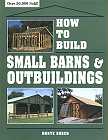
Click
image to order
|
How
to Build Small Barns & Outbuildings
by Monte Burch, and Ben Watson (Editor)
This book has a lot more to
it than
just barns and outbuildings. You can use it to build a hen house, root
cellar or woodshed and get some basic building skills in hand. Then,
when you are ready, the book will help you layout several other stick
frame, post and beam and pole barn type structures. The drawings are
clear, the photos are from real buildings, and the how-to-build
information is timeless. Because it covers several specific building
projects rather than generic building situations, you feel like you
learn more and are more ready to build. Some of the buildings have
nearly complete building plans included in the book. This is perfect
for the owner-designer looking for a basic structure to modify for
their own site and needs.
This inexpensive resource is
also a
good guide to low-cost construction. Just good country building - solid
but without fluff and gingerbread.
|
|

